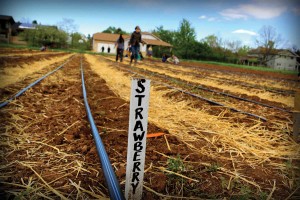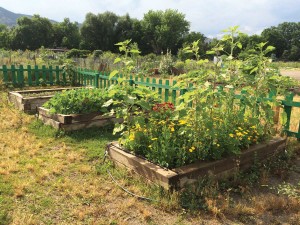Coming to Fruition
13 Oct 2014
An urban orchard is taking root right in the heart of Boulder.
By Lisa Truesdale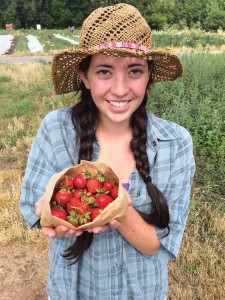
- Savannah Snody of Growing Gardens proudly displays some of the very first strawberries harvested this past summer from the new urban orchard being planted at Boulder’s Growing Gardens.
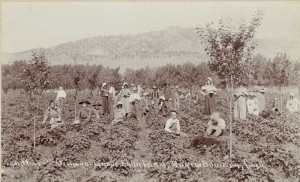
- Historically, Boulder County was the site of many orchards, including the Orchard-Grove Fruit Farm (left), once located in north Boulder.
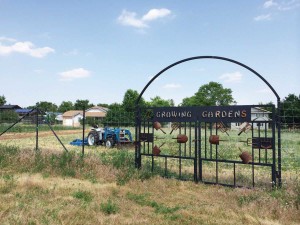
- Tree-planting is scheduled for next spring. When complete, Growing Gardens’ orchard will contain nearly 200 trees, including apples, pears, plums, peaches, cherries and apricots.
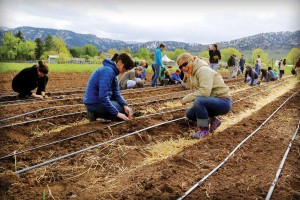
- A cadre of volunteers helped plant the berry patch. More volunteers will be needed next spring to plant trees.
Feeding Families
When tree-planting is completed (it’s scheduled for spring 2015), the orchard will boast nearly 200 fruit trees, including apple, pear, plum, peach, cherry and apricot, and Richardson expects strong fruit production by the third season. By the fifth year, she predicts the trees should produce enough fruit so that Growing Gardens will be able to share its bounty with a number of local food-rescue organizations. For now, harvested fruit goes to shareholders in the ¡Cultiva! Youth Project’s Community-Supported Agriculture (CSA) program. ¡Cultiva! is an organic plot operated by teens aged 12-19, who do all the planting, nurturing and harvesting. It’s just one of the many hands-on educational farm opportunities hosted on the Growing Gardens property that is still owned by the Long family. On July 9, the first bushels of strawberries were harvested from the 2,000 plants established in May, and Richardson says everyone who assisted with the harvesting was excited to see the delicious “fruits” of their labor. “People need to get used to the idea of looking in their own backyards for fresh food, and our new orchard is all about introducing fresh fruits,” she says. “The best way to do that—and the best way to get kids excited—is through something sweet. Everyone loves fruit!”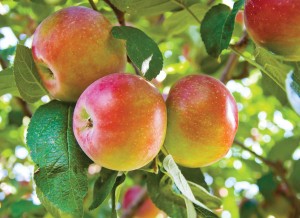 Fruit Tree Facts
Fruit Tree Facts
We asked Mikl Brawner, co-owner of Harlequin’s Gardens at 4795 N. 26th St. in Boulder, for tips for those who want to grow fruit trees. Here is his valuable advice:
- Spring is the best time to plant fruit trees. Plant trees in sheltered spots that have gradual winter temperature drops and gradual spring warm-ups.
- Fruit trees can be planted almost any time of the year, except not too close to winter because the roots won’t have a chance to grow into the soil, and therefore may dry out and die before spring.
- Fruit trees grow best in well-drained soil. If you have clay soil, mix in coarse organic material, such as aged manure, to a depth of at least 12 inches. Thoroughly mix in the organic material for optimal air and water penetration.
- Most fruit trees prefer full sun. Don’t plant trees too close to buildings, particularly on south and west exposures, as this can cause them to bloom early and subject them to frost damage.
- Buy plants adapted to Colorado conditions.
- Container-grown fruit trees means their entire root system is intact and ready to grow, unlike field-dug trees.
- When planting, the important thing is to dig a wide hole that’s not deeper than the root system (the depth of the pot or the root ball). Water the hole before planting, wet the root ball and dust it with powdered mycorrhizae (a symbiotic fungus), or sprinkle it with water-soluble mycorrhizae.
- After planting, apply wood-chip mulch 3 inches deep and as wide as the tree’s branching. Brawner suggests a finer wood chip made from local trees such as maples, oaks, willows or hackberries. He doesn’t suggest redwood or -cedar, as they resist decay and repel microorganisms, and have a much larger -carbon footprint. Never let mulch touch the trunk, he adds, as the bark will decay. Leave 1 or 2 inches of space between the mulch and the trunk.
- Keep trees watered so the soil is moist but not soggy. After the trees are established, usually in a year’s time, they’ll need less water.
- Not all fruit tree varieties are self-fertile; some need a pollinator. Check with nursery experts before you buy your trees.

